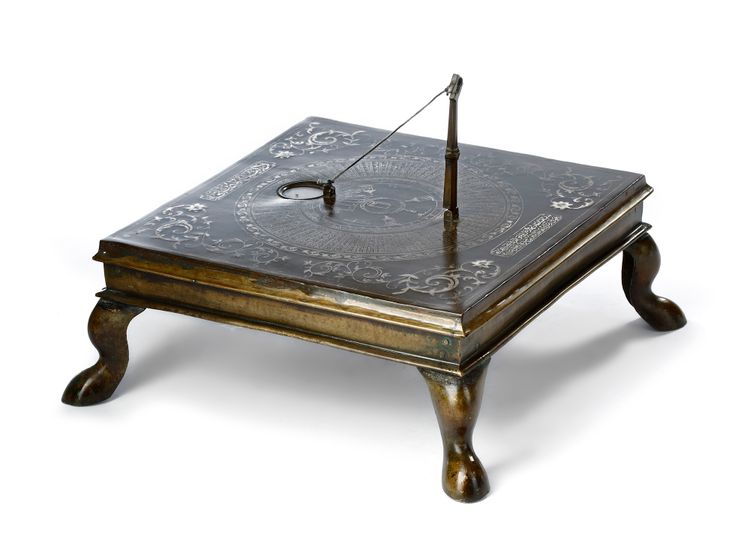A BRONZE/BRASS QUADRUPED OTTOMAN QIBLA FINDER, PROBABLY MADE FOR THE SULTAN MEHMED V, EARLY 20TH CENTURY
This quadruped qibla finder board features two sundials, a compass and a circular geographical table in the folk tradition of Islamic science known as a 72-sector scheme of scared geography indicating the qibla directions of groups of localities from the Islamic world. The markings and some of the mechanical characteristics of the instrument seem to be a direct copy of the ivory sundial qibla finder made by a certain Bayram ibn Ilyas in 1582, and which is now in the collection of the British Museum.
TECHNICAL DESCRIPTION
The Qibla finder engravings on this instrument are identical to the ivory sundial in the British Museum made by Bayram ibn Ilyas.
The technical description of the part which is identical to the British Museum instrument is as follows:
The qibla finder instrument consists of a circular table along the rim of the instrument featuring a 72- sector scheme of sacred geography (i.e folk tradition of Islamic science). Each quadrant is divided into 18 sectors of 5 degrees each and each of the sectors are inscribed with a group of cities/localities from the Islamic world.
Concentric to the circular table, bordering to the inner rim, are markings for the first sundial which shows the equinoctial hours and hour angle (with divisions for each degree). On the center of the instrument, there is a representation of the Ka’ba with a circular fence around it. Around the Ka’ba are the places of prayer (maqam) of the four legal schools.
Below the Ka’ba, there is a second sundial in the shape of a scarlet sail, showing the time of the ‘asr prayer and each of the four hours before it. Both sundials are facilitated by a string-gnomon pointing towards the celestial pole. The string-gnomon is held up by a collapsible strut.
On the left of the sail shaped marking there is a Turkish inscription indicating “oruç saati” (“fasting time”). Next to it the name of the maker: Bayram ibn Ilyas. Above the letter “s” of the word “Ilyas” the date 990 ( AH) is given. This corresponds to 1582 AD. This is obviously not the date at which this instrument was made.
At the bottom of the instrument on top of the 180 degrees position of the circular table, there is circular hole for a magnetic compass.
In addition to the “Bayram ibn Ilyas” markings, the instrument furthermore features two inscriptions in a box on top and at the bottom and decorations with floral patterns on the left and right of the instrument.
The inscription on top of the instrument states “dalil al-musalla” or “guide for the mosque”, while the inscription on the bottom is a poetic dedication to a Sultan Mehmed/Muhammad, which might be the Ottoman Sultan Mehmed V.
26 by 26 cm.
Height 10.5 cm.
LITERATURE
For more detailed information on the ivory sundial on which this qibla finder is based see:
Meghan Doyle, “The Whole World in His Hands: What a Qibla Indicator Illuminates About Islamic Community in Sixteenth-Century About Islamic Community in Sixteenth-Century Ottoman Turkey”, Global Tides: Vol. 12 (2018) , Article 8. Available at: https://digitalcommons.pepperdine.edu/globaltides/vol12/iss1/8
David King, World Maps for Finding the Distance and Direction to Mecca: Tradition and Innovation in Islamic Science. Brill, Leiden, 1999, p. 116-117
Venetia Porter, The Art of Hajj: Journey to the Heart of Islam, British Museum Press, London, 2012, p. 66






